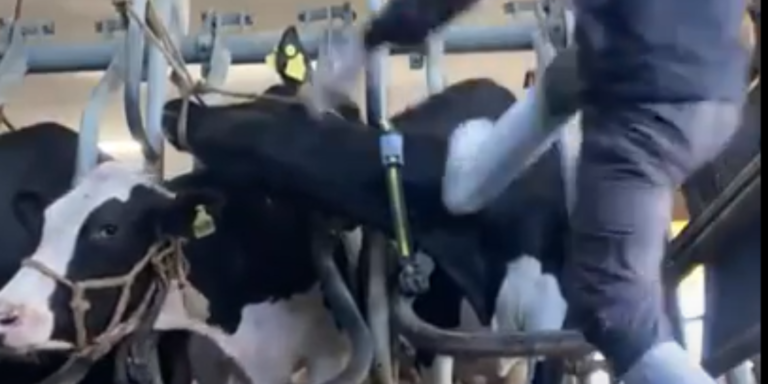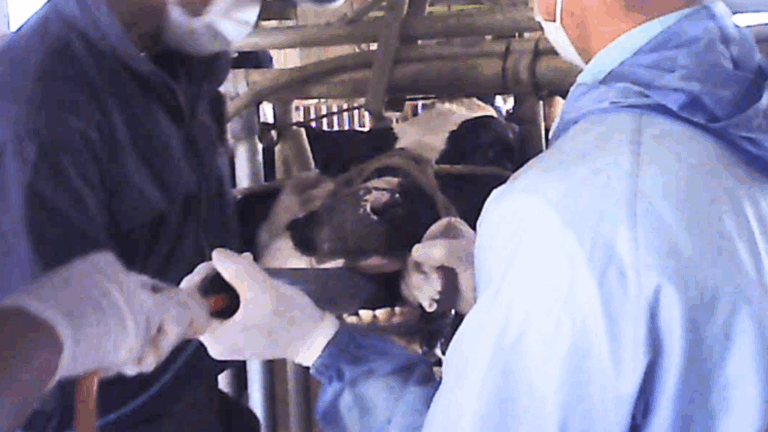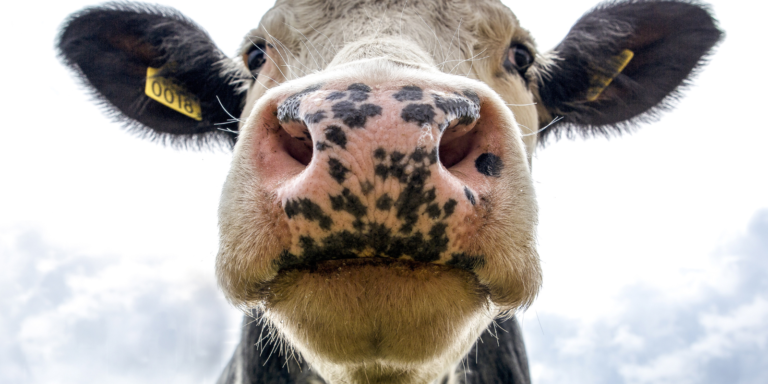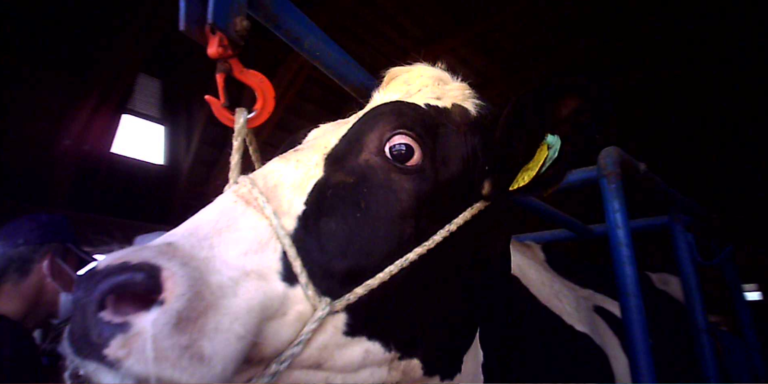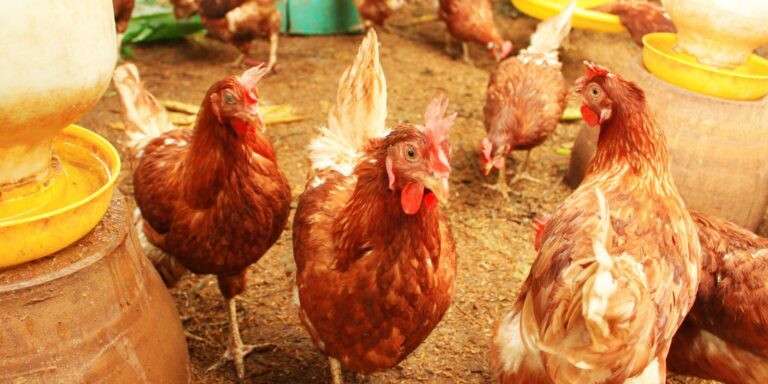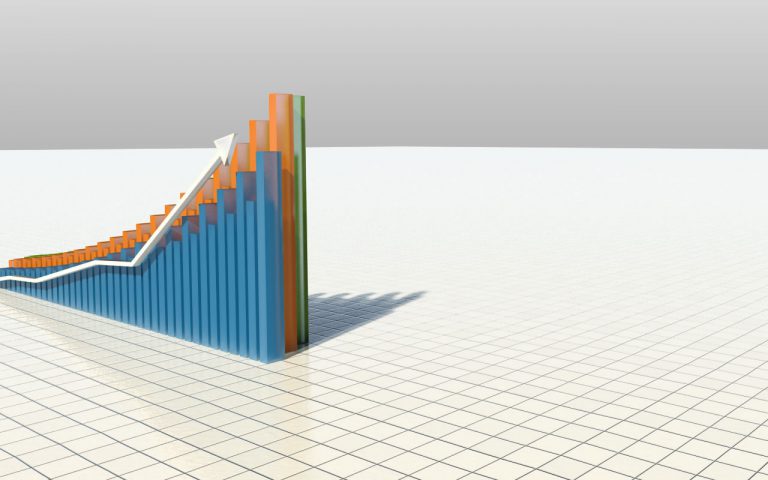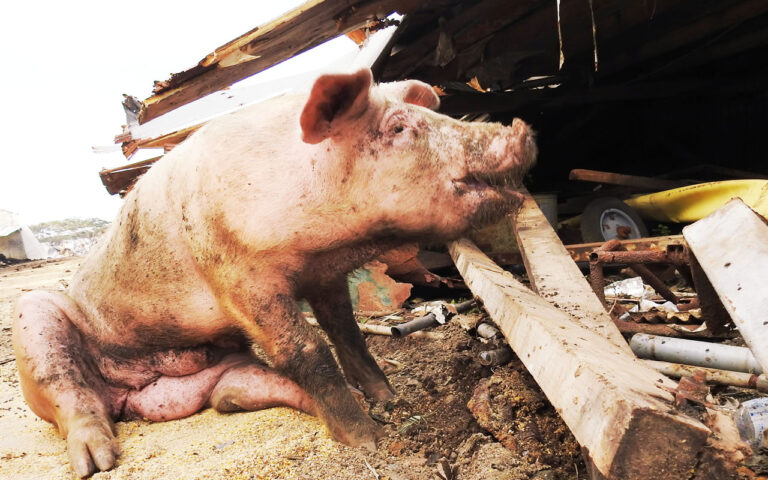In June 2023, a video of an assault on a dairy cow at the Ohdahara farm in Shimane Prefecture was spread on social media, and investigated by the prefectural police. While media reports only a rough description of the assaults, the video clearly shows that the cows were subjected to repeated and severe beatings.
In the 2 minute 40 second video, which consists of both Video 1 and Video 2, one employee (referred to as Employee A) commits the following violence:
- Poking the cow’s eye 9 times for about 15 seconds.
- 6 kicks.
- 1 punch.
- 1 slap.
Some people claim that it is impossible for farmers to assault cows because it affects the quality of the milk, and that farmers treat their cows with love and affection like family members. However, in reality, assaults on dairy cows are frequently witnessed on other farms as well. Due to their size, more forceful acts of violence are more likely to occur to cowsIn the middle of this video, another employee appears in the background, but they do not show any sign of concern regarding these actions. This indicates that acts of violence against dairy cows are not uncommon on this farm. Claims that they are watchful of each other’s actions because they work in pairs on the dairy farm are hard to believe.
These acts of violence are believed to constitute a violation of Article 44(2) of the Act on Welfare and Management of Animals. Furthermore, the corporation (farm) responsible for their management is considered to be in violation of Article 48(2). It is entirely unreasonable that although these acts fall under the penalties of the Animal Welfare and Control Law, they are not subject to punishment as a business, unlike pet shops and similar establishments. The livestock industry is not included in the animal handling industry under the Act on Welfare and Management of Animals, which makes less effective in deterring animal abuse. Businesses like pet shops become cautious because their operations can be suspended when they face fines or more severe penalties In the livestock industry, such awareness is lacking, and until just a few years ago, many people were unaware that the livestock industry was subject to penalties under the Animal Welfare and Control Law – that is the prevailing situation in Japan. The Act on Welfare and Management of Animals has long lacked specific provisions for the livestock industry and has further excluded livestock from the animal handling industry. However, it is necessary to correct this attitude
Not everyone resorts to persistent and senseless assaults like Employee A. However, in the livestock industry where animals don’t always behave as expected, there is a certain number of employees who resort to violence or abuse with animals.
Acts of Violence in Video 1 (1 min and 14 sec)
At 0:11, Employee A, holding a tethering rope, kicks the area from the cow’s eye to her mouth with his right foot (using the full sole of the shoe.).
At 0:21, Employee A, wearing thin vinyl gloves on their right hand, pokes the left eye of the dairy cow. The dairy cow’s leg shifts to the right in response to the pain, lasting for approximately 2 seconds.
※At this time, the right side of the cow’s face is visible, and it seems the right eye is injured.
At 0:56, Employee A pokes the left eye of the dairy cow with their finger for the third time. The dairy cow raises her left front leg in response to the pain, lasting for approximately 1 second.
※At 1:06, the tethering rope is pulled forcefully, rendering the dairy cow’s face completely immobile.
At 1:09, Employee A kicks the base of the cow’s neck on the left side with their right foot, using the full sole of the shoe. At this time, there is a pipestall running through the back of the cow’s neck on the opposite side and nose , and the impact of the kick may have caused damage to the right side of the cow’s neck and nose.
At 1:11, Employee A delivers a second kick to the same spot using the full sole of shoe. At this time, there is minimal blurring of the dairy cow’s face, and it appears that the nose did not hit the pipe. However, there is a potential for injury to the back of the right neck
At 1:12, Employee A delivers a third kick to the same spot, which is slightly lower than the second kick (hitting with the sole of the shoe between the toe and the arch of the foot). During this time, there is minimal blurring of the dairy cow’s face, and it appears that the nose did not hit the pipe. However, there is a potential for injury to the back of the right neck.
At 1:14, as Employee A attempts to deliver a fourth kick to the same spot, Video 1 ends.
Acts of Violence in Video 2 (1 min and 26sec)
At 0:24, Employee A, wearing thin vinyl gloves on their left hand, pokes the right eye of the dairy cow with his fingers. The dairy cow shakes her face to the right in response, lasting for approximately 1 second.
At 0:27, Employee A pokes the right eye of the dairy cow for the second time using their right hand’s index and middle fingers. The dairy cow reacts by shaking her face back in pain, lasting for approximately 1 second.
At 0:28, Employee A pokes the right eye of the dairy cow for the third time, as the cow moves her face in response to being poked in the eye. The dairy cow displays signs of discomfort, lasting for approximately 1 second.
At 0:29, Employee A slaps the cow on the chin with his right hand (slaps up from below)
At 0:31, Employee A pokes the right eye of the dairy cow for the fourth time using their right hand’s fingers wearing thin vinyl gloves. The dairy cow raises her face in response, lasting for approximately 3 seconds.
At 0:38, Employee A’s right hand fingers may have entered the dairy cow’s left eye.
At 0:39, Employee A pushes the cow’s face up from under her left cheek with his right hand.
At 0:46, Employee A pokes the right eye of the dairy cow for the fifth time using his right hand’s fingers. The dairy cow raises her face in discomfort, looks to the left, and then flaps her legs, lasting for approximately 1 second.
※At 0:49, another employee appears to shower the cow from behind, and the cow turns her back further.
At 0:55, Employee A punches the right neck of the dairy cow with his right hand.
At 0:58, Employee A kicks the dairy cow in the right neck with his right foot (kicking with the entire sole of the shoe or the area between the toe and the arch of the foot.
At 1:11, Employee A, holding a tether rope, kicks the left cheek of the cow with his right foot (kicking with the toe portion of the shoe.)
At 1:21, Employee A, for the sixth time, porks his fingers into the left eye of the cow with his right hand. The cow’s legs shift to the right side, reacting to the pain, for approximately 3 seconds.
An Issue that Concerns All Consumers.
The incident of violence against dairy cows took place in Shimane Prefecture, and many consumers may believe it doesn’t concern them. However, that’s a misconception. In reality, it affects every consumer who purchases milk and dairy products in Japan.
In Japan, raw milk from farms is stored in bulk coolers before being transferred to tanker trucks that come for collection. These tanker trucks visit multiple farms, which means that, at this stage, the raw milk from different farms gets mixed (excluding farms that engage in self-sales).Raw milk from various farms, once mixed, is eventually collectively sold by ten designated producer groups (agricultural cooperatives) across the country. Dairy manufacturers then purchase this milk, and each company labels it with their brand, packaging it into milk cartons or processing it into products like yogurt and cheese for everyday consumers to purchase. This is how the system works in Japan.
In other words, anyone in Japan might be consuming milk from this abused cows. You may have paid for this violence and the suffering of this dairy cow by purchasing her milk or dairy products.
The Violence is Not Limited to the Dairy Cows at the Ohdahara Farm.
Violence on other farms has also been reported numerous times in the past, and such acts indeed occur. However, the dairy industry has consistently denied these allegations, and mutual protection has prevented any meaningful self-purification in the industry. The mutual protection among them has also been negatively influenced by the above-mentioned shared sales system (centralized collection, diversified distribution). Furthermore, the dairy industry can see as few as 200 farm departures in a year or even more than 400 in some cases. The fear of going out of business and the resulting decrease in milk production is contributing to the willful ignorance of these issues.
The practices on one farm can affect the sales destinations of milk from another farm, so it becomes easier to deny or conceal these issues. It has led to a situation of turning a blind eye to what is happening on neighboring farms. At least, such situations have been observed in the areas known to the Animal Rights Center Japan (ARCJ). There have been instances where we reported to organizations that provide subsidies to farms, and we ended up facing severe reprimands in response. As many of you are aware, when the ARCJ turned real-life episodes into a manga, it led to a major backlash. Even in this case, we’ve noticed that dairy farmers are cautioning each other about posting the video but treating the issue of violence as if it doesn’t concern them.
We don’t know why, but not only dairy farmers but also the general public believe that farmers would never do something as terrible as assaulting their cows. However, we must emphasize that, unfortunately, the reality is that the potential for violence always looms in places where a large number of animals are kept.
Statements such as ‘We treat our cows with affection like family,’ ‘We handle our chickens with care,’ or ‘Our pigs are stress-free’ without any evidence to support them are examples of animal welfare washing. Food companies that source livestock products claim to ‘comply with laws and regulations,’ but one must understand that in the livestock industry, complying with laws and regulations is an extremely challenging feat. Dairy farming is conducted with substantial subsidies funded by our taxes, but the reality lurking behind it can be viewed as a betrayal to consumers.
It’s time to move away from milk and dairy products. We are in an era where we can replace everything, from the café latte we drink at cafes to cheese, yogurt, and the milk we use in cooking, with plant-based alternatives.


